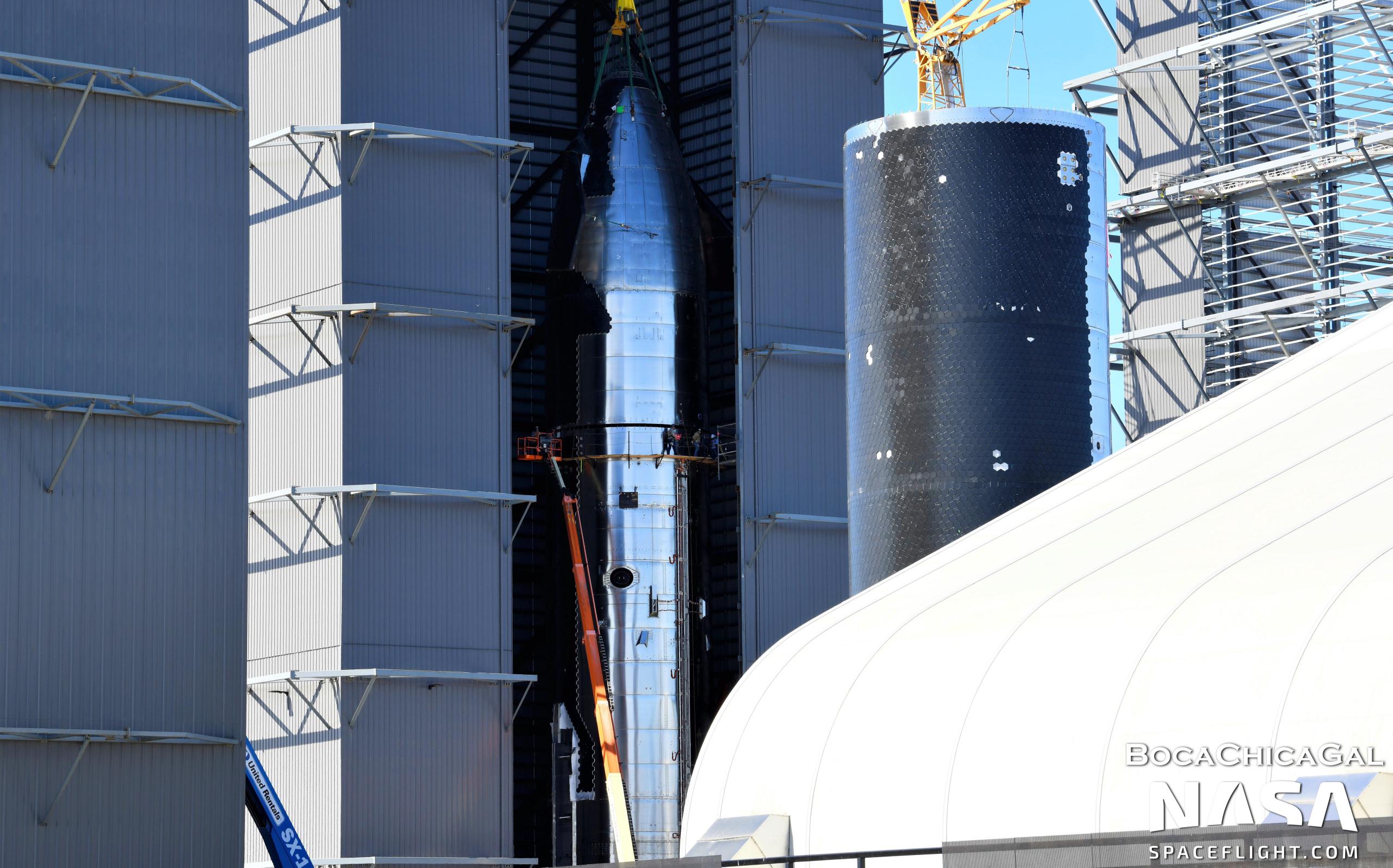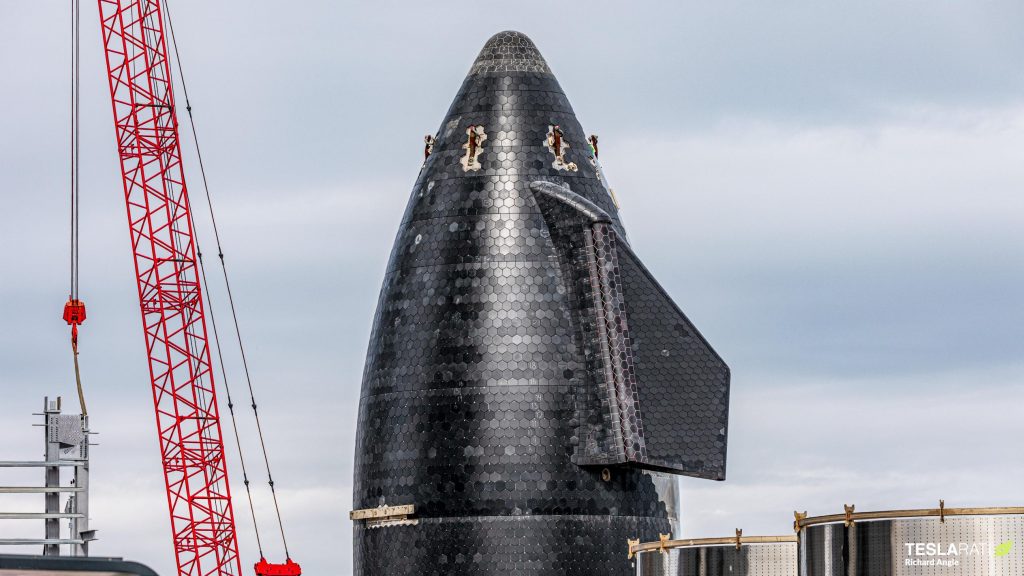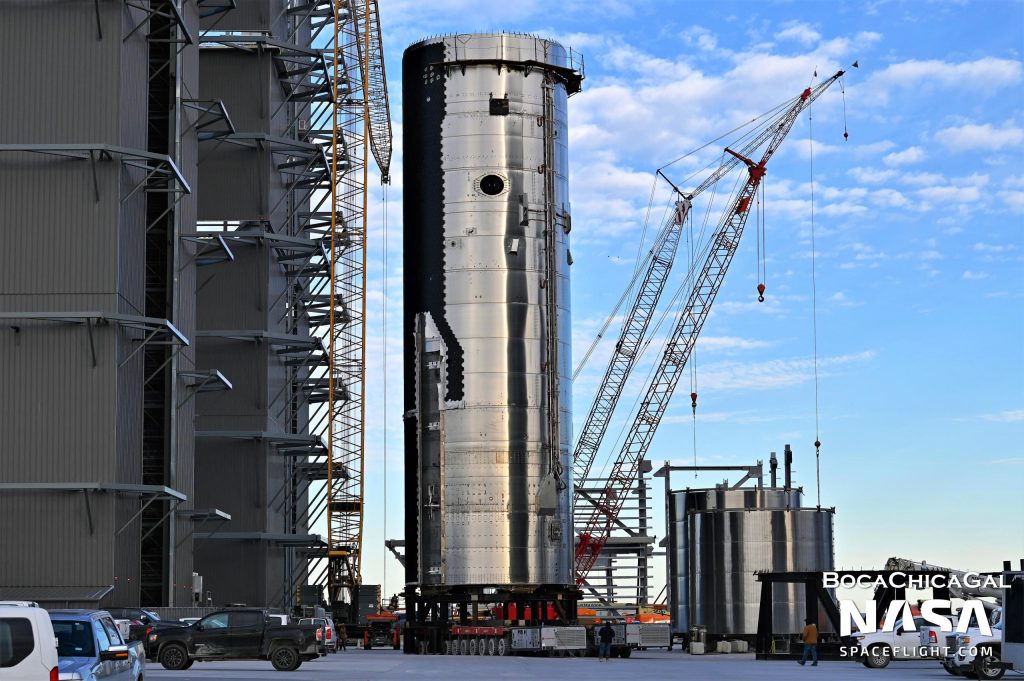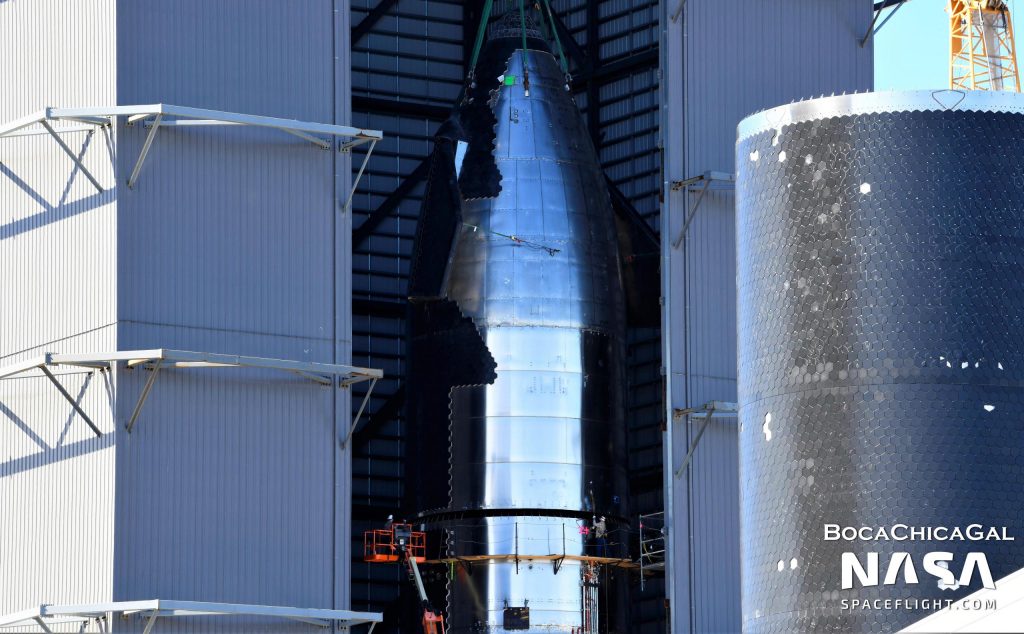

News
SpaceX finishes stacking new Starship for the first time in six months
For the first time in more than half a year, SpaceX has stacked a new Starship prototype to its full height, hopefully marking the end of a period of relatively slow progress.
That period began when Starship S20 was stacked to its full height in early August 2021. Until very recently, Ship 20 was said and expected to be the prototype assigned to Starship’s first orbital test flight, making it exceptionally important. In an unusual change in attitude, SpaceX may have felt the same, which may explain why Starship S20’s first static fire test took place more than two months after it first left the factory. A year prior, Starships SN9, SN10, SN11, and SN15 all completed proof testing a matter of weeks after rollout.
That sudden change of pace relative to past development has meant that Ship 20 is the only Starship prototype SpaceX has tested since May 2021 and the only Starship to graduate from final assembly to testing in the last six months. In that period, Ship 20 has completed a few major cryogenic proof tests and four static fires – two of which ignited all six Raptor engines. While Ship 20’s six-engine tests were unprecedented and marked a major program milestone, SpaceX once static-fired Starship SN9 three times in one day in January 2021.
However, that period of sluggish prototype testing may finally be coming to an end. In August 2021, when SpaceX stacked Starship S20 and Super Heavy B4 for the first time, the general assumption was that the seemingly imminent march towards orbital flight testing would be similar to SpaceX’s attempts to land a Starship from medium altitude between December 2020 and May 2021 – lots of prototypes in flow and multiple back-to-back tests and launches, in other words. That was not the case.
Starship S21, for example, began final assembly in mid-October 2021 and its tank section and nose section were both fully stacked less than a month later. However, rather than stack them into a second complete ship, SpaceX has left those separate assemblies sitting around Starbase for the last three months. Simultaneously, while Ship 21’s apparent limbo seemed to imply that SpaceX was implementing another block upgrade and moving on to newer prototypes, the company actually started stacking Starship S22 about a week after S21’s separate sections were completed. Only three months later have SpaceX’s plans for those three sections finally become clear.
On February 14th, 2022, Ship 22’s tank section followed Ship 21’s nose section into Starbase’s high bay assembly facility, where they were quickly stacked to form a full Starship prototype the same day. This raises the question: why?



Given that Starship S20 effectively completed qualification testing with three successful static fires in December 2021 and a fourth in early January 2022 and has been seemingly ready to fly ever since, its Super Heavy booster readiness – not ship readiness – that appears to be holding SpaceX back. Perhaps because of pad readiness issues, SpaceX has yet to perform a single Super Heavy static fire test – or even a less risky wet dress rehearsal – at the orbital launch site. As such, it’s hard to say why SpaceX has suddenly decided to finish Ship 22 instead of focusing on a newer version of Starship (S24) and Super Heavy (B7) – both of which are expected to debut upgrades.
It’s possible that Ship 22 is being completed merely as practice for the Starbase workforce, who have gone half a year without fully assembling another ship prototype, but then there would have been no reason not to install Ship 21’s nose on Ship 21’s tank section instead of withholding it for Ship 22. Ship 22 could also be a replacement for Ship 21 if appearances are misleading and SpaceX uncovered issues with the older prototype during testing but again, no booster is ready to launch either ship.
Regardless of the outcome or purpose of Ship 22, seeing any new Starship prototype completed is an exciting and interesting change of pace after half a year of following the windy paths of Ship 20, Booster 5, and Ship 21 to their uncertain goals.
News
Tesla UK sales see 14% year-over-year rebound in June: SMMT data
The SMMT stated that Tesla sales grew 14% year-over-year to 7,719 units in June 2025.

Tesla’s sales in the United Kingdom rose in June, climbing 14% year-over-year to 7,719 units, as per data from the Society of Motor Manufacturers and Traders (SMMT). The spike in the company’s sales coincided with the first deliveries of the updated Model Y last month.
Model Y deliveries support Tesla’s UK recovery
Tesla’s June performance marked one of its strongest months in the UK so far this year, with new Model Y deliveries contributing significantly to the company’s momentum.
While the SMMT listed Tesla with 7,719 deliveries in June, independent data from New AutoMotive suggested that the electric vehicle maker registered 7,891 units during the month instead. However, year-to-date figures for Tesla remain 2% down compared to 2024, as per a report from Reuters.
While Tesla made a strong showing in June, rivals are also growing. Chinese automaker BYD saw UK sales rise nearly fourfold to 2,498 units, while Ford posted the highest EV growth among major automakers, with a more than fourfold increase in the first half of 2025.
Overall, the UK’s battery electric vehicle (BEV) demand surged 39% to to 47,354 units last month, helping push total new car sales in the UK to 191,316 units, up 6.7% from the same period in 2024.
EV adoption accelerates, but concerns linger
June marked the best month for UK car sales since 2019, though the SMMT cautioned that growth in the electric vehicle sector remains heavily dependent on discounting and support programs. Still, one in four new vehicle buyers in June chose a battery electric vehicle.
SMMT Chief Executive Mike Hawes noted that despite strong BEV demand, sales levels are still below regulatory targets. “Further growth in sales, and the sector will rely on increased and improved charging facilities to boost mainstream electric vehicle adoption,” Hawes stated.
Also taking effect this week was a new US-UK trade deal, which lowers tariffs on UK car exports to the United States from 27.5% to 10%. The agreement could benefit UK-based EV producers aiming to expand across the country.
News
Tesla Model 3 ranks as the safest new car in Europe for 2025, per Euro NCAP tests
Despite being on the market longer than many of its rivals, the Tesla Model 3 continues to set the bar for vehicle safety.

The Tesla Model 3 has been named the safest new car on sale in 2025, according to the latest results from the Euro NCAP. Among 20 newly tested vehicles, the Model 3 emerged at the top of the list, scoring an impressive 359 out of 400 possible points across all major safety categories.
Tesla Model 3’s safety systems
Despite being on the market longer than many of its rivals, the Tesla Model 3 continues to set the bar for vehicle safety. Under Euro NCAP’s stricter 2025 testing protocols, the electric sedan earned 90% for adult occupant protection, 93% for child occupant protection, 89% for pedestrian protection, and 87% for its Safety Assist systems.
The updated Model 3 received particular praise for its advanced driver assistance features, including Tesla’s autonomous emergency braking (AEB) system, which performed well across various test scenarios. Its Intelligent Speed Assistance and child presence detection system were cited as noteworthy features as well, as per a WhatCar report.
Other notable safety features include the Model 3’s pedestrian-friendly pop-up hood and robust crash protection for both front and side collisions. Euro NCAP also highlighted the Model 3’s ability to detect vulnerable road users during complex maneuvers, such as turning across oncoming traffic.
Euro NCAP’s Autopilot caution
While the Model 3’s safety scores were impressive across the board, Euro NCAP did raise concerns about driver expectations of Tesla’s Autopilot system. The organization warned that some owners may overestimate the system’s capabilities, potentially leading to misuse or inattention behind the wheel. Even so, the Model 3 remained the highest-scoring vehicle tested under Euro NCAP’s updated criteria this year.
The Euro NCAP’s concerns are also quite interesting because Tesla’s Full Self-Driving (FSD) Supervised, which is arguably the company’s most robust safety suite, is not allowed for public rollout in Europe yet. FSD Supervised would allow the Model 3 to navigate inner city streets with only minimal human supervision.
Other top scorers included the Volkswagen ID.7, Polestar 3, and Geely EX5, but none matched the Model 3’s total score or consistency across categories. A total of 14 out of 20 newly tested cars earned five stars, while several models, including the Kia EV3, MG ZS, and Renault 5, fell short of the top rating.
Elon Musk
Why Tesla’s Q3 could be one of its biggest quarters in history
Tesla could stand to benefit from the removal of the $7,500 EV tax credit at the end of Q3.

Tesla has gotten off to a slow start in 2025, as the first half of the year has not been one to remember from a delivery perspective.
However, Q3 could end up being one of the best the company has had in history, with the United States potentially being a major contributor to what might reverse a slow start to the year.
Earlier today, the United States’ House of Representatives officially passed President Trump’s “Big Beautiful Bill,” after it made its way through the Senate earlier this week. The bill will head to President Trump, as he looks to sign it before his July 4 deadline.
The Bill will effectively bring closure to the $7,500 EV tax credit, which will end on September 30, 2025. This means, over the next three months in the United States, those who are looking to buy an EV will have their last chance to take advantage of the credit. EVs will then be, for most people, $7,500 more expensive, in essence.
The tax credit is available to any single filer who makes under $150,000 per year, $225,000 a year to a head of household, and $300,000 to couples filing jointly.
Ending the tax credit was expected with the Trump administration, as his policies have leaned significantly toward reliance on fossil fuels, ending what he calls an “EV mandate.” He has used this phrase several times in disagreements with Tesla CEO Elon Musk.
Nevertheless, those who have been on the fence about buying a Tesla, or any EV, for that matter, will have some decisions to make in the next three months. While all companies will stand to benefit from this time crunch, Tesla could be the true winner because of its sheer volume.
If things are done correctly, meaning if Tesla can also offer incentives like 0% APR, special pricing on leasing or financing, or other advantages (like free Red, White, and Blue for a short period of time in celebration of Independence Day), it could see some real volume in sales this quarter.
You can now buy a Tesla in Red, White, and Blue for free until July 14 https://t.co/iAwhaRFOH0
— TESLARATI (@Teslarati) July 3, 2025
Tesla is just a shade under 721,000 deliveries for the year, so it’s on pace for roughly 1.4 million for 2025. This would be a decrease from the 1.8 million cars it delivered in each of the last two years. Traditionally, the second half of the year has produced Tesla’s strongest quarters. Its top three quarters in terms of deliveries are Q4 2024 with 495,570 vehicles, Q4 2023 with 484,507 vehicles, and Q3 2024 with 462,890 vehicles.
-

 Elon Musk4 days ago
Elon Musk4 days agoTesla investors will be shocked by Jim Cramer’s latest assessment
-

 News1 week ago
News1 week agoTesla Robotaxi’s biggest challenge seems to be this one thing
-

 Elon Musk2 weeks ago
Elon Musk2 weeks agoFirst Look at Tesla’s Robotaxi App: features, design, and more
-

 News2 weeks ago
News2 weeks agoWatch Tesla’s first driverless public Robotaxi rides in Texas
-

 News2 weeks ago
News2 weeks agoSpaceX and Elon Musk share insights on Starship Ship 36’s RUD
-

 News1 week ago
News1 week agoWatch the first true Tesla Robotaxi intervention by safety monitor
-

 News2 weeks ago
News2 weeks agoTesla has started rolling out initial round of Robotaxi invites
-

 Elon Musk2 weeks ago
Elon Musk2 weeks agoTesla to launch in India in July with vehicles already arriving: report


















